[Data Mining in Politics]
Visualizing Similarity with Distance
Copyright (c) Aleks Jakulin,
2004. [e-mail] (remove
unnecessary dashes and spaces from the e-mail address to respond)
We have to distinguish similarity, which is in our case defined through a
statistical model, and distance defined geometrically. We can employ various
algorithms with the purpose of presenting the statistical similarities in the
form of distances, clarifying the structure in data.
The colors are derived from bloc memberships in the latent variable model.
The perceptual similarity of color marks the similarity as it arises in the
latent variable model.
Principal Component Analysis:
This is the most frequently used method of analyzing high-dimensional data.
Each senator can be understood as a variable. Should we consider each of the
senators and the outcome, we would have a 101-dimensional space. Fortunately,
because of correlations and structure in the senators' votes, we can project the
data to a lower-dimensional space which nevertheless captures most of the
variation. The two dimensions can be seen as representing axes of variation. The
horizontal one separates Democrats from Republicans, while the vertical
one is a bit more difficult to characterize.
However, it is important to assume how to represent situations when a senator
did not vote. Of course one can obtain the maximum likelihood values (what is
the most likely vote for the senator), but this carries certain assumptions. On
the other hand, we can represent each senator with two dimensions (201
dimensions overall), but we are not particularly interested in modeling when
someone would or would not vote. The following diagrams examine the arrangement
of senators as obtained by PCA, but depending on the assumption of how to
interpret "Not Voting". Depending on the imputation method, two dimensions
captured 70.0% - 77.2% of total variation, as assessed by the R^2 statistic.
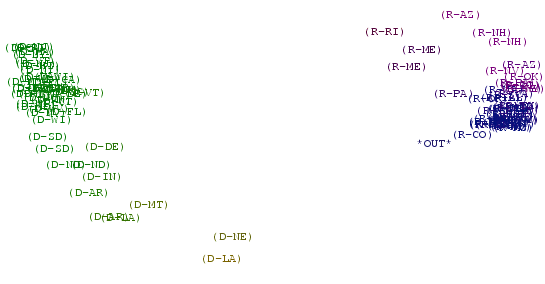 |
Imputation by Absence
We assume that when a senator did not vote, we are
best off guessing that he or she would vote like those senators that
usually vote similarly as our senator. We "interpolate" the missing
values. This corresponds to a situation when a senator was prevented
from voting, or would want to vote but could not.
The outcome is near the Republican aggregation of
points. |
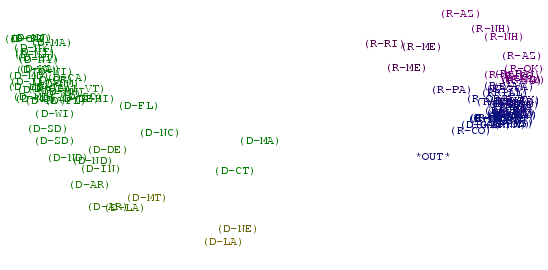 |
Imputation by Stratagem
By stratagem we assume that the senator did not vote
consciously. This corresponds to letting the majority decide in his
name.
We observe that those senators that did not vote often
(e.g., Kerry (D-MA) and Lieberman (D-CT) ) end up in the space between
both parties. |
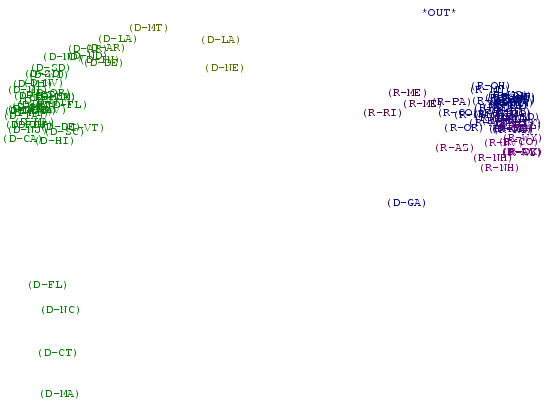 |
Imputation by Submission
By submission we mean that a senator did not vote
consciously because he or she could not change the outcome of the vote.
Therefore, the true vote is understood to be the opposite of the
eventual outcome.
The senators that did not vote often (Kerry (D-MA),
Lieberman (D-CT), Edwards (D-NC) and Graham (D-FL) ) end up in a
separate branch. |
Multi-Dimensional Scaling with Rajski's
distance:
We represent each senator as a point in space, and compute the distance
between each of them using Rajski's distance. We then try to place the positions
of senators so that the Euclidean distance is as close to the similarity as
possible. This problem is referred to as multi-dimensional scaling.
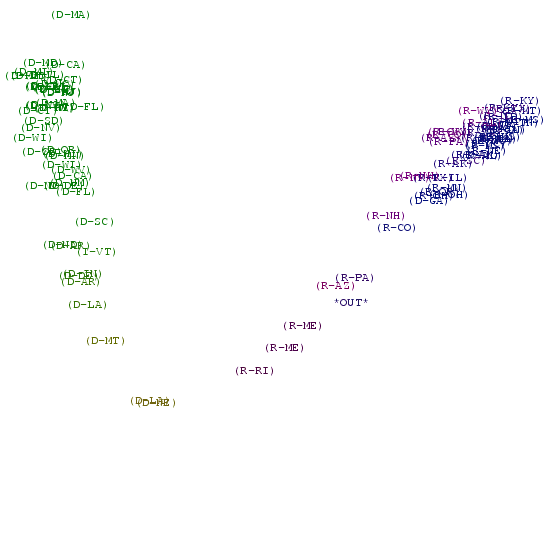 |
Torgerson's MDS procedure
This is a very fast procedure based on the Singular
Value Decomposition algorithm. This procedure is usually used as the
first approximation before applying SMACOF. |
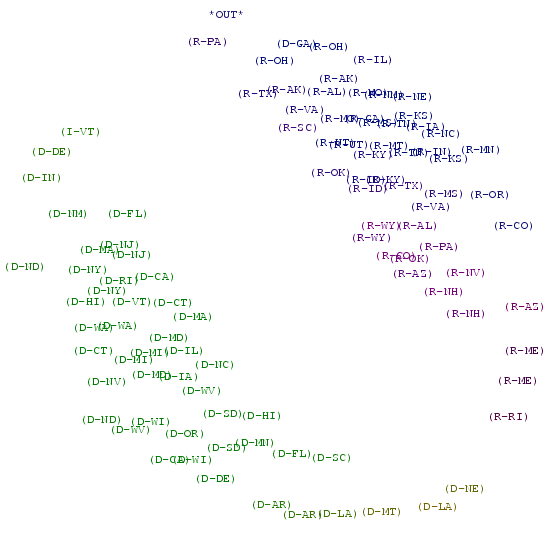 |
SMACOF MDS procedure
This is an iterative procedure for matching
similarities with Euclidean distances. The points are moved iteratively
in a hypothetical space in order to best capture the Rajski's distance
between each pair of senators. |
Binary PCA:
De Leeuw's "binary
PCA" attempts to explain the votes with a simpler statistical model. Each senator
is represented as a point, and each issue is represented as a line that
separates those who voted for from those who voted against a particular bill.
The separation is not perfect, but the algorithm attempts to move the ideal
points around so that the error that these lines make is as low as possible.
Similarity between senators is not considered explicitly, but indirectly through
the representation of votes. This model is one of several in the family of
"classification" models (because the objective criterion is how well we can
classify the votes). These models are most similar to those typically used in
political science for interpreting the roll call data. It must be noted,
however, that the modern models in political science are based on assumptions
about decision-making and utility: the models we examine do not concern
themselves with decision-making, solely with representation.
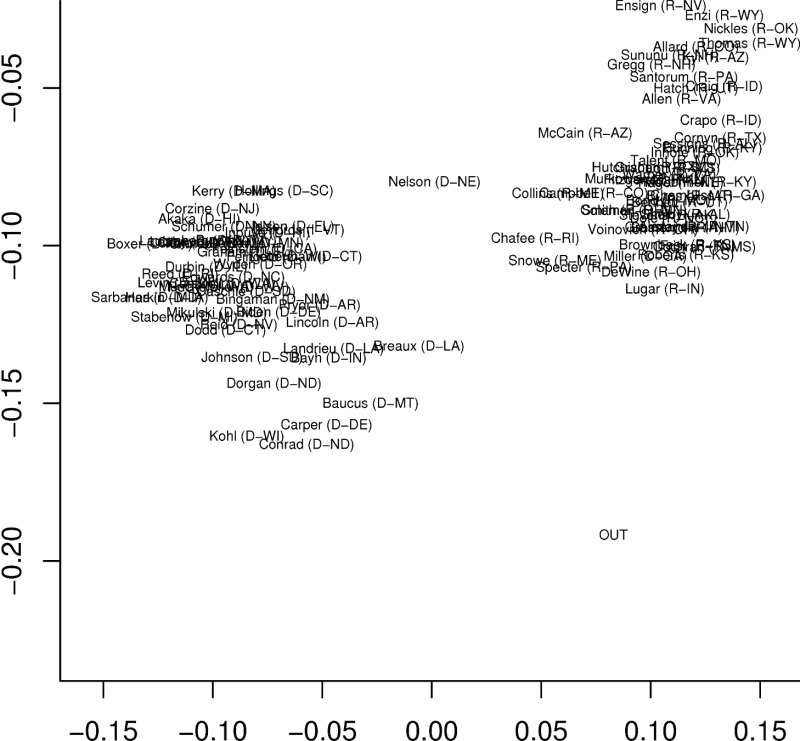 |
Ideal Points
Each senator is placed somewhere in the 2D space.
Although the similarity between senators is not a criterion in the
optimization, we observe a very similar structure of groups as with the
analyses above. |
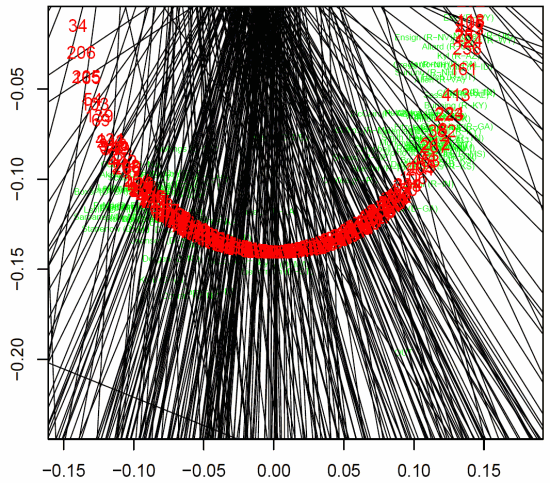 |
Votes
Each vote can be represented as a line that separates
the senators who voted for and against the issue. The objective
criterion is to minimize the number of misclassifications.
We can see that most of the votes split the Democrats, but very few
votes split the Republicans. In a few cases, the vote was unanimous:
note the lines around the edges of the diagram. |
The issue of John Kerry:
National Journal
claimed that Kerry is an
extreme liberal. This was disputed by many, including Kerry himself. Poole
claims that Kerry is liberal but not extreme [link,
link], Clinton,
Jackman & Rivers say that it's hard to say due to his absenteeism but also that
Kerry is not extreme
[PDF link].
However, one should interpret "Not Voting" as letting the
majority vote for you. Since the majority is Republican, the fact that Kerry
often did not vote means that he is effectively the most central of all
Democrats, based on all the votes cast in 2003.






